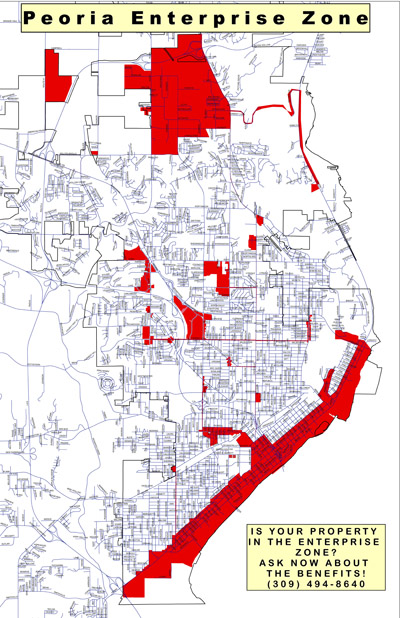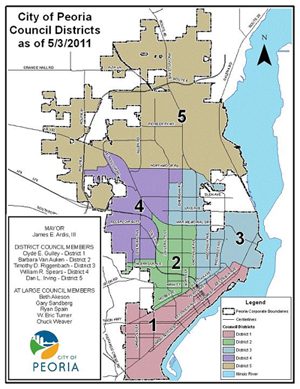At the last City Council meeting, the council discussed the Pioneer Parkway extension project, which would extend Pioneer Parkway from Allen Road three miles west to Trigger Road, crossing Routes 6 and 91 along the way. The objection was raised that we’ve been unable to adequately maintain the streets we currently have (in all districts, incidentally), and perhaps a better use of our limited funds would be to maintain our current assets before they deteriorate further. In fact, there has been no sealcoating or overlayment of our city streets (not including roads maintained by the state or federal government) since 2009.
In response, Councilman Spain had this to say:
I’ve never been one that really thought that an activity taking place in one part of our community has to come at the expense of another location. And I think we have a lot of things happening in Peoria that are positive for all parts of the city. And to say that a project like this that we’ve been working on for a long time shouldn’t move forward is pretty disappointing to me. And when you think about the activities and successes that we’ve experienced with growth in the northern parts of the city, I think that has been important. That doesn’t mean we should stop our efforts to grow the older parts of the city.
But the reality of our current tax base is that the real estate taxes paid in Councilman Irving’s district are about equal to all the real estate taxes paid in all four other districts combined. And so I think it’s important that we acknowledge that, and I appreciate your leadership on this issue, Councilman, and I think this will be another project that is important for the city and something that’s used to sustain services throughout the city so that we can continue investing in all parts of the community.
I first wanted to find out if it’s true that the fifth district generates 50% of the City’s real estate tax revenue, so I went looking for some sort of report that breaks down real estate tax receipts (or at least equalized assessed valuation information) by city council district. I checked with the Finance Department, the County Assessor, the City’s Planning & Growth and Economic Development departments, and even the Heartland Partnership — none of them had such a report. So I asked Mr. Spain how he came up with his figures, and he was kind enough to provide me with a detailed explanation:
My comments are based on preliminary work we have been doing with available EAV [equalized assessed valuation, or property value] information. The current EAV in the City is more than $2B. The D150 [Peoria Public Schools District 150] EAV is about $1.4B, about 70% of the total City. In Peoria, council districts 1-4 are almost exclusively within D150 (The exception to that is a small part of the 4th in Limestone). So at a maximum, the total real estate taxes of districts 1-4 is 70% of the City total. But we also know that there are large areas of the 5th district that are also in D150. Neighborhoods like WeaverRidge, High Point, Hawley Hills, Edgewild, Lynnhurst, Huntington, Oak Crest, and Charter Oak. I’ve attached a map that overlays our current council districts with Peoria County school districts -its a pretty good sized area of the 5th district that is still part of D150. We think there is enough property included in both the 5th district and D150 to represent about 20% of total City EAV.
Plausible, but I don’t know that I’d put it on the record as a fact without qualification the way Spain did at the last meeting. His analysis is based on some big assumptions. And, ultimately, it won’t matter much once the district boundaries are redrawn in a few months.
The bigger question is, what difference does it make? The issue at hand was whether we should use our limited funds to build a new road or maintain our existing roads. Existing roads are in poor condition all over the city — including the wealthy fifth district. I’m unclear as to what the relative wealth of the fifth district had to do with the item under consideration.
Mr. Spain, who lives in the fifth district himself, says he doesn’t think “an activity taking place in one part of our community has to come at the expense of another location.” True, but nobody said it does. Money given to one project, however, does indeed come at the expense of another project. Money spent on new city logos can’t be spent on police or fire protection. Assets given away for the downtown museum and hiking/biking trails cannot be used to generate tax revenue. And money spent on a study to extend Pioneer Parkway can’t be used to sealcoat existing streets.
Mr. Spain was no doubt trying to make the point that this proposed new road would open up more land for development, which would generate more tax revenues, which could then be used to benefit the whole city. And he probably was trying to say that finishing the study puts the city in a position to take advantage of state and federal grants for road construction (i.e., it makes the project “shovel-ready”). Those are reasonable, if not persuasive, arguments.
Unfortunately, what Mr. Spain actually said was, “the real estate taxes paid in [the fifth] district are about equal to all the real estate taxes paid in all four other districts combined” and that “it’s important that we acknowledge that,” which sounds like class discrimination, pure and simple. I don’t think he meant it that way (at least, I hope not), but I do think it was a poor choice of words.
In his e-mail to me, Mr. Spain also said one other thing in his defense, so I’ll give him the last word in this post: “Since it was not mentioned in your live blogging, I want to reiterate my position that investment in older parts of the City is just as important as investment in growth areas. I’ve really worked hard to find dollars for the older areas of the City -I was disappointed you didn’t acknowledge that.”


